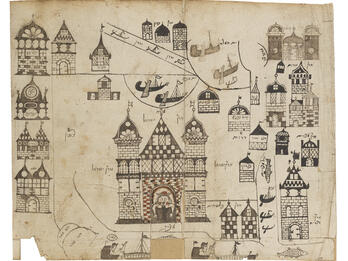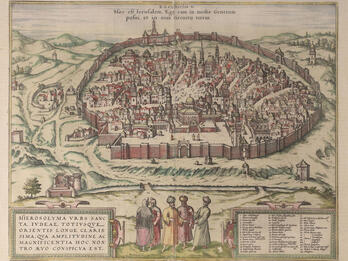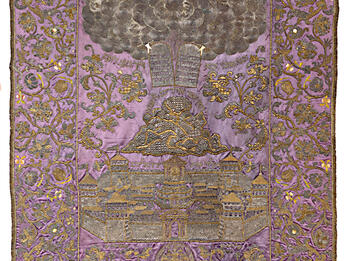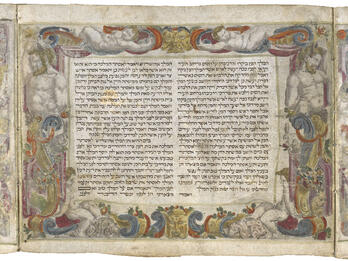Shalshelet ha-kabalah (The Chain of Tradition): History of Late Antiquity
In Which Is Explained the Order of the Generations and the History of Every Single Generation
In the days of Antigonus, in about 3160 of creation, roughly 52 of the second rule of Ptolemy II over Egypt; he took the land of Israel away from the Seleucids by cunning. He was a persecutor of Israel, and he came to Jerusalem and drove out more than one hundred twenty thousand Jews and sold them as slaves. After the death of the aforementioned Seleucus, Antiochus ruled in his stead in the kingdom of Macedonia, and toward the end of his days he conquered the land of Israel from Ptolemy, king of Egypt. He, too, was a great persecutor of Israel, and he killed sixty thousand Jews and exiled ten thousand of them to Antioch. [ . . . ] For Gabinus [Aulus Gabinus], the Roman consul came upon them and brought them under the Roman rule in the days of Janai [Alexander Jannaeus], king of Israel, in approximately the year 280 from the construction of the [Second] Temple. That was the generation of Hannibal, a philosopher and great hero and man of war, who commanded the army of the people of Carthage. He went far and succeeded in all his wars against the Romans until he was opposed by Scipio Africanus, who was also very wise and a Roman consul. He fought with Hannibal and defeated him and drove him out of Italy and his army fled from him. [ . . . ]
In that generation there were many philosophers in every country, some of whom I will mention here. Terence led the exiles when the Romans captured the city of the Carthaginians. [ . . . ] Empedocles was the main believer that the soul does not die with the body, and therefore he threw himself into a fire and was burned. The philosopher Diogenes hated all earthly pleasures and did not eat or drink or sleep except when nature demanded it, while all his faculties were devoted to learning. [ . . . ]
Marcus Regulus was a very wise man and a minister of the army from Rome that fought against the Carthaginians. He was captured in the war, but later the Carthaginians sent him by himself to intervene with the Romans to make peace with them. Before he departed, he swore to them that if the Romans did not wish to make peace he would return to their prison. He then went and advised the Romans to not make peace with them, because they were at a disadvantage, and he wanted to return to the Carthaginians, as he had sworn to keep his oath, even though his return was against the will of the elders and his associates and intimates, and the Carthaginians put him to death.
In his days, the sects of the Tsadokim [Sadducees] and the Bitusim [Boethusians] were renewed. [ . . . ] And according to the [book] Josippon it appears that at that time the Jews were divided into three sects, the Perushim [Pharisees], the Tsadokim, and the Isoaim [Essenes]. It is written there that in some places there was also a fourth sect, founded by Judah ha-Gavloni from the land of the Galilee, which was later wiped out, in the days of Alexander, a Roman official. There is also a record of another sect that went to live in the desert and that sect also quickly died out. I have seen it stated that the Tsadokim and the Bitusim were two distinct sects, as the Tsadokim were more evil and had less faith. The Kuzari [written by Judah ha-Levi (ca. 1075–1141)] in section III, mentions the sect of the Karaites as well. And I have seen in chronicles that many sects were formed in the world at that time, and they are the Nokoloti, Aryani [Aryans], Manikoao [Manicheans], Armino Nistoriano, Abortini, Irnagaria, the poor of Daliano in Aldinso, and many others. Those who came from wars of Flanders told me that there are more than twenty-two sects and creeds there, including one that believes only in the simple meaning of the Torah, like the faith of Tsadok and Boethus. Meanwhile, beyond the rivers of Kush, in the kingdoms of Prester John, are those who convert and accept the faith of fire, and some of them accept that faith of water and others believe in idolatry, while among the Ishmaelites there are also the sects of Muhammad [Sunni] and the sect of Ali [Shi’a].
Translated by
.
Credits
Gedaliah Ibn Yaḥya, “Shalshelet ha-kabalah (The Chain of Tradition): History of Late Antiquity,” in Shalshelet ha-kabbalah (Venice, 1587). Republished as: Gedaliah Ibn Yaḥya, Shalshelet ha-kabalah: Bo mevo’ar seder ha-dorot ve-korot kol dor ve-dor (Jerusalem: Hotsa’at ha-dorot ha-rishonim ve-korotam, 1961), pp. 235–246.
Published in: The Posen Library of Jewish Culture and Civilization, vol. 5.






![M10 622 Manuscript, probably from Ukraine]. Manuscript probably from Ukraine, c. 1740 with a broad collection of practical kabbalah and mystical magic. Facing page manuscript arranged vertically with Hebrew text in the shape of a figure wielding two long objects.](/system/files/styles/entry_card_sm_1x/private/images/vol05/Posen5_blackandwhite166_color.jpg?h=cec7b3c9&itok=Sz6u21MQ)
